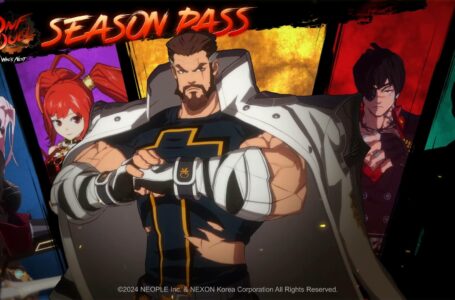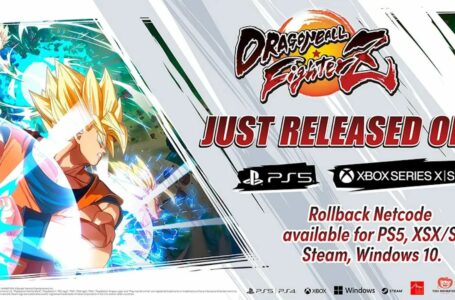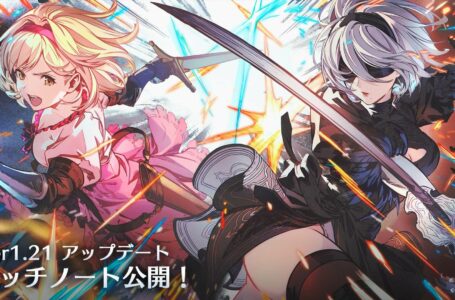Attack the Backlog: Rockin’ out to Double Dragon Neon (#1)
I thought we’d take a brief break from Trinity Universe, ’cause although I’m enjoying it a great deal, I’m also aware that umpteen episodes of an unpopular PlayStation 3 RPG might not be what you’re looking for on a daily basis — although rest assured, we will be returning to it. Today, instead, we’re shifting gear completely and taking a look at Double Dragon Neon — specifically, the recent Nintendo Switch port.
Now, technically this game hasn’t really been on my “backlog” in the traditional sense in that I have only owned a copy since my boxed version from Limited Run Games plopped through my letterbox last week — but it is a game that I have been meaning to play pretty much ever since it originally launched on the Xbox 360 and PlayStation 3 digital storefronts.
I had been holding off on it for various reasons, though — primarily the fact that I was often hesitant to pick up digital downloads on the Xbox 360 due to how easily they get lost and forgotten amid the dog’s dinner of an interface the “New Xbox Experience” is. (I could have bought it on PS3, I know, but I typically went for multiplatform titles on Xbox 360 for some reason that I can’t really explain.) When the Nintendo Switch version was released digitally, I thought “hmm, WayForward already has a good relationship with Limited Run Games, I bet there’ll be a boxed copy at some point” — and sure enough, there was indeed.
Anyway, my rambling non-history with the game aside, this seemed like the ideal opportunity to finally play the damn thing. So that’s absolutely what I did.
Double Dragon Neon looks familiar but fresh
From the moment the game started with a bunch of thugs wandering up to Marian, punching her in the gut and then wandering off with her over their shoulder, I knew that this was a game taking the Double Dragon thing seriously. While the game’s setup implies that it’s a follow-up to the past Double Dragon games — Player 1 protagonist Billy Lee comments something along the lines of “not this again” as he bursts onto the scene — it’s also very clearly designed to pay homage to the original Double Dragon — in both its arcade and NES incarnation, since both were considerably different games from one another.
One thing you’ll doubtless quickly notice as soon as you start playing is that Double Dragon Neon has a surprisingly “heavy” feel to it. In contrast to series like Final Fight and Streets of Rage, where tapping the attack button is quite a “rapid-fire” process until you actually connect with an enemy, in Double Dragon Neon there’s a distinct sense of weight to all your movements — including both attacking and simply moving around.
Of particular note is the fact that the “run” move — something you couldn’t do in the original Double Dragon games — has a significant wind-up to it, which takes a bit of getting used to if you’re accustomed to simply double-tapping a direction to go charging off that way.
This weighty feel is definitely an acquired taste, since if you’re accustomed to more obviously “Japanese” beat ’em ups, it will take a period of adjustment for you to understand how Double Dragon Neon does things. But at the same time, it works well for the game; Billy and Jimmy feel like lumbering hulks who can really put some power behind their strikes, and consequently the combat feels like it has some real heft to it.
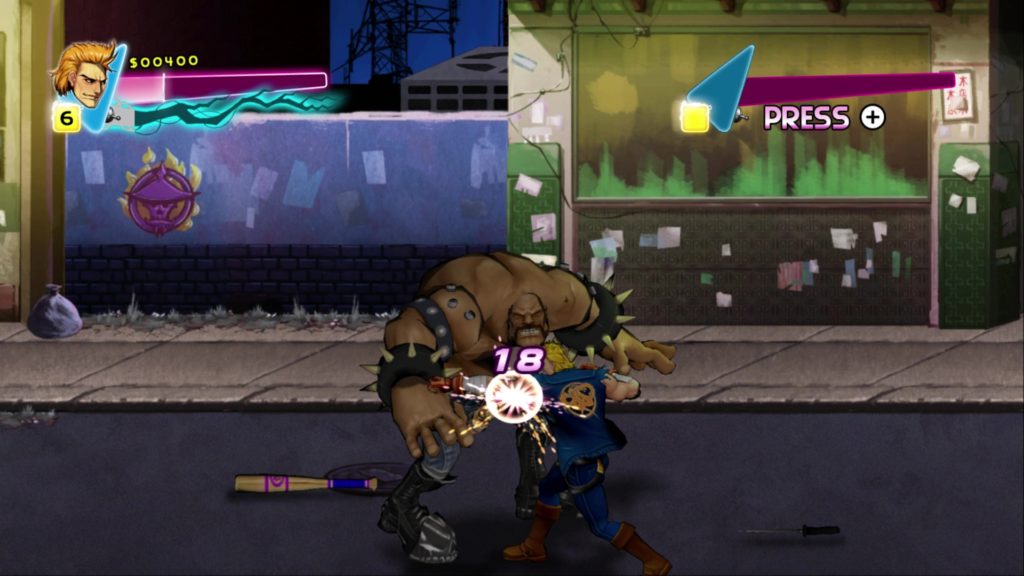
One side effect of this seeming sluggishness is that early in your time with the game, you’ll doubtless feel like it’s all too easy to take damage — and, like the original arcade games, taking just a single hit from an enemy can knock a large chunk of life off.
The game’s tutorial is quick to point out that you have a “duck” move available to you, and that timing this correctly triggers a “Gleam” state where you do double damage for a few seconds, but it doesn’t emphasise quite how critical this is, nor that combining the duck with a direction allows you to roll to the left or right with some generous invincibility frames.
Once you get a feel for it, though — which you naturally will as you play the game, since it’s hard not to feel “hmm, I probably shouldn’t be taking this much damage” after a short period in the field — it’s immensely satisfying, and the Gleam mechanic makes taking down certain enemies significantly more straightforward; foes that take a right old pummelling become possible to take down in the space of a single combo.
Speaking of foes, Double Dragon Neon does a great job with them. Many of them are inspired by classic enemies from the old arcade and console games — and WayForward does a great job of giving them both clear, individual personalities and some obvious animation cues that let you know when you should be dodging and when you should be attacking.
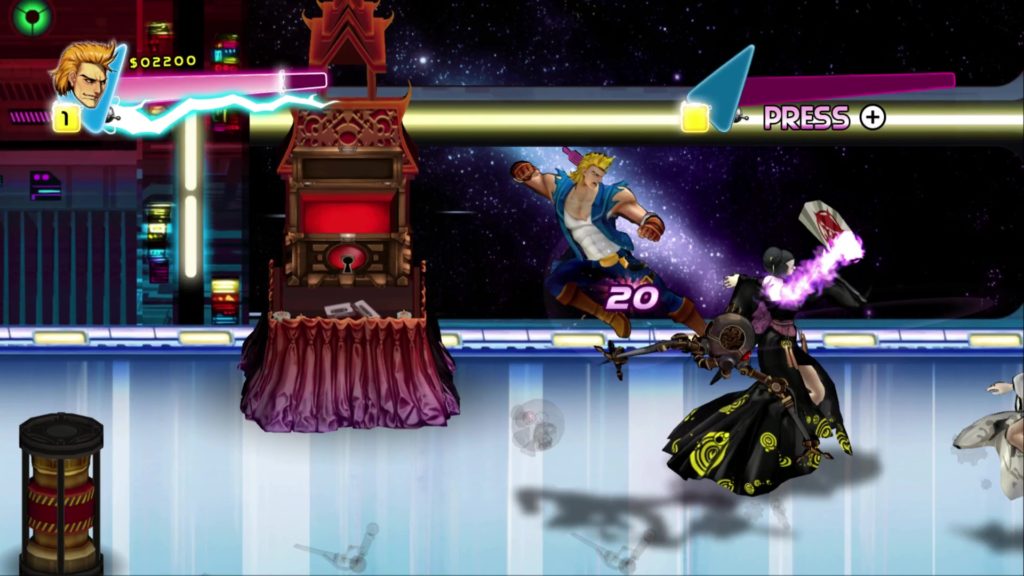
Before long, you’ll come to the conclusion that Double Dragon Neon actually places a somewhat stronger focus on defence than many other beat ’em ups — while a core feature of the genre as a whole is still managing space and ensuring that you don’t get surrounded, Double Dragon Neon builds on that with a sense that timing your attacks during convenient openings is of critical importance, rather than simply charging in flailing and hoping that you’ll be able to overwhelm your foes.
Part of this is down to the fact that Double Dragon Neon is a beat ’em up that has been specifically designed for play in the home, and as such it can afford to incorporate somewhat more elaborate mechanics than traditional arcade games, which require immediacy and accessibility to keep those quarters coming in. It’s also an example of what series creator Yoshihisa Kishimoto described as the game being “a very Western adaptation of Double Dragon” during its development, as reported by Polygon in 2020.
It makes sense; although Double Dragon is indisputably a Japanese series at heart, it has always had a somewhat more American (or at least America-inspired) feel to it than the Kunio-kun series to which it is tangentially attached. While Kunio-kun is about warring rival high school kids, Double Dragon is about brawling through gangland — and often onward into somewhat unexpected territory. In that context — and particularly given the game’s distinctively ’80s-inspired aesthetic — it makes perfect sense for Billy and Jimmy to be bro-tastic high-fivin’ dudes.
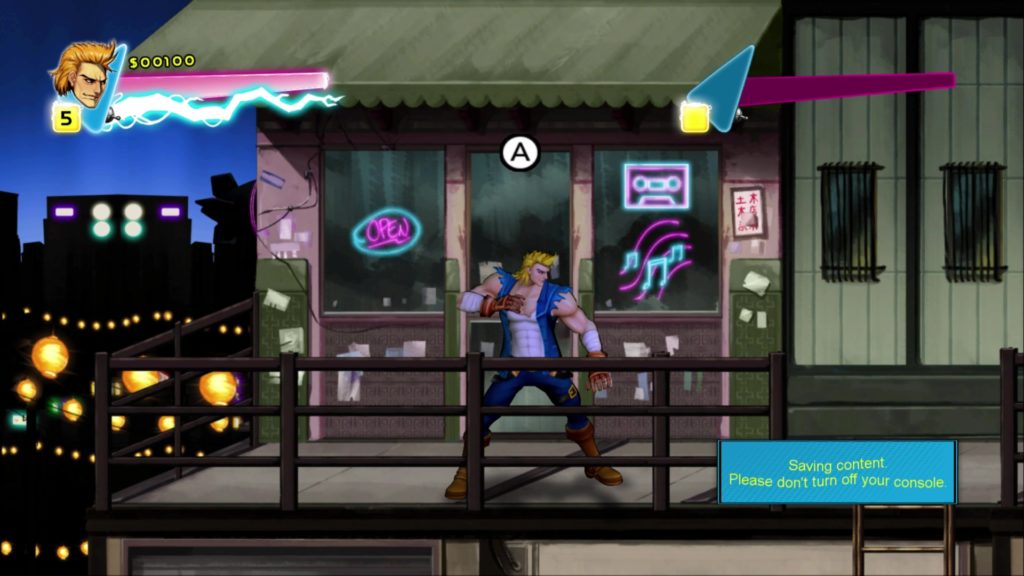
And as for that aesthetic — whoo, mama. While the shift to a 3D polygonal style was controversial for some longstanding series fans — including those who were a big fan of WayForward’s amazing pixel art work in series like Shantae — few can deny that the game does a great job of capturing the feel of a cheesy ’80s cartoon, particularly once the distinctly Skeletor-inspired Skullmageddon enters the picture.
The real highlight of the aesthetic experience, though, is the music, which is loud, brash and enormously catchy. It blends original new themes — often with vocals — with classic music heard in both the original arcade and NES versions of various Double Dragon games, and it’s consistently excellent.
My only real gripe with the overall soundscape of the game is that at its default volume levels, the awesome music completely drowns out most of the humorous dialogue — though even if you turn it down, much of the speech is still quite difficult to hear, since it has a distinctly echoey “arcade game announcer” feel to a lot of it. I suspect this is deliberate — it’d just be nice to hear Skullmageddon in particular a little more clearly, since he’s one of the most hilarious villains ever created.
Or even just some subtitles would be nice, since this is a curious omission from the game’s options.
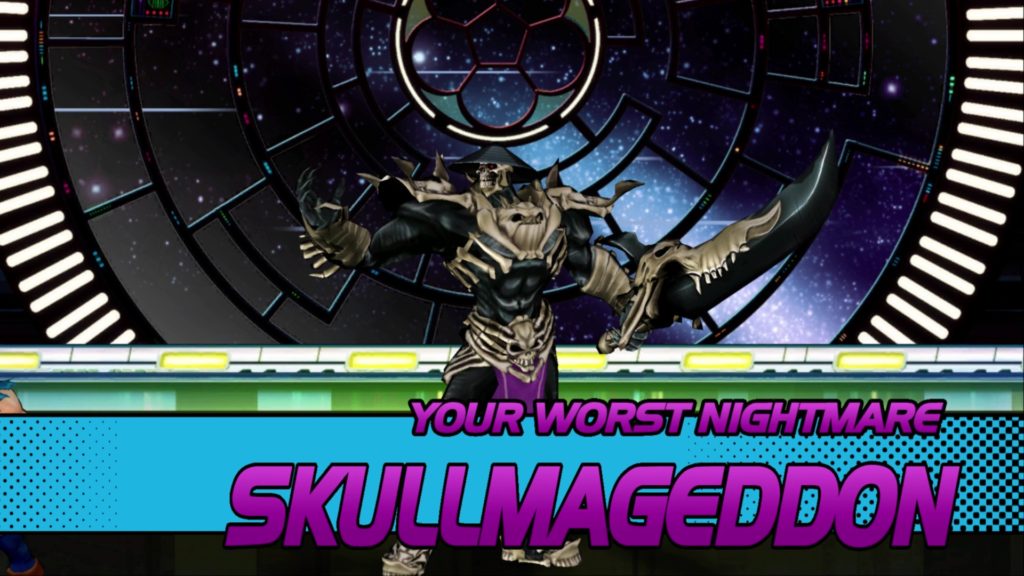
Anyway, in the hour or so of play you see above, I got a good feel for the game, and I feel more confident approaching and tackling the game’s more significant challenges from here. We’ll return to this next week and take a closer look at some of the game’s more interesting mechanics, such as its equippable “tapes” system — but suffice to say for now that I’m having an absolute blast with Double Dragon Neon, and if you haven’t already experienced it, too, it comes highly recommended.
Double Dragon Neon is available for Nintendo Switch, PC, Xbox 360 and PlayStation 3.
Join The Discussion
Rice Digital Discord
Rice Digital Twitter
Rice Digital Facebook
Or write us a letter for the Rice Digital Friday Letters Page by clicking here!
Disclosure: Some links in this article may be affiliate links, which means we may earn a small commission if you make a purchase after clicking on them. This is at no additional cost to you and helps support Rice Digital!
- Letter from the Editor: passing the torch - June 30, 2023
- Super Woden GP 2 is looking promising - June 30, 2023
- Inti Creates is making a 32 bit-style Love Live action platformer - June 26, 2023





